Accommodations for Neurodivergent Students
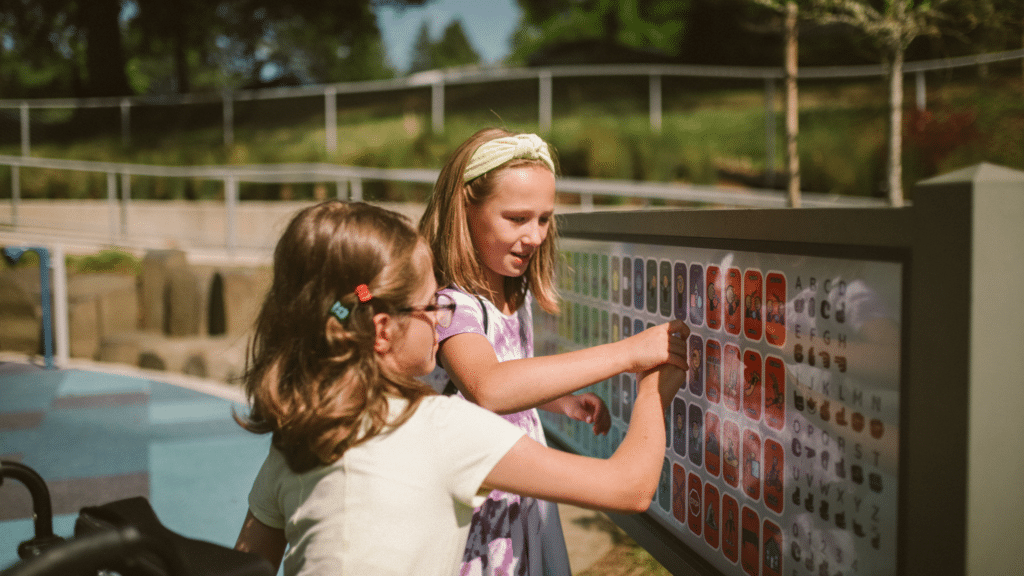
Enhancing Digital Inclusivity: A Comprehensive Evaluation and Recommendations for Augmenting Support for Neurodivergent Students in Palo’s SEL Program
The digital age has transformed how individuals acquire knowledge, with the internet being a primary resource. However, the quest for learning can be stifled by poorly designed digital interfaces. This issue extends to classrooms where digital learning has become integral, especially post-COVID-19 (Explorance, 2023). Although digital learning presents numerous advantages like access to varied information and enhanced communication, poorly designed digital experiences can hinder material accessibility, leading to sub-optimal learning outcomes.
The shift to digital learning has been substantial, as illustrated by a survey from Education Week, where 90% of school district leaders confirmed providing a device for every middle and high school student, and 84% for elementary school students. However, this shift potentially marginalizes students who are already vulnerable, especially if their unique needs for information accessibility are overlooked.
Neurodivergent students, those with neurological differences such as learning disabilities, intellectual disabilities, autism spectrum disorder, and ADHD (Singer, 2017), face significant challenges in this digital transition. Online educational tools often fall short in catering to their unique learning needs, as mainstream technology tools often overlook the requirements of neurodivergent learners. The lack of proper accommodations in classrooms heavily reliant on digital platforms further marginalizes these students (Luke, 2023). A promising avenue to support neurodivergent students is the implementation of school-based Social and Emotional Learning (SEL) programs. Evidence suggests that SEL enhances self-awareness, and academic success, and develops interpersonal skills like forming healthy relationships, managing emotions, and fostering empathy. These skills are particularly beneficial for neurodivergent students, aiding them in better adapting to classroom environments, gaining confidence, and developing self-advocacy skills.
This study seeks to delve into the effectiveness of SEL programs, the potential of technology in addressing the learning needs of neurodivergent students, and the broader implications of digital learning on educational equity and inclusivity. The objective is to unravel how technology can be leveraged to foster a more inclusive learning environment, particularly for neurodivergent students.
The Imperative of Inclusive Praxis in Palo’s Digital SEL Resource: Assessing Inclusivity
In an educational landscape where digital learning is burgeoning, ensuring inclusivity within digital Social and Emotional Learning (SEL) resources, particularly for neurodivergent students, emerges as a linchpin to foster equity in classrooms. Often, the conventional scholastic environment overlooks the unique challenges neurodivergent students encounter while navigating various subjects. SEL can be a powerful tool for these students, providing them with novel strategies to manage and mitigate issues stemming from their learning differences. The essence of inclusivity in online resources, thus, pivots on embedding accommodations that engender a supportive learning milieu for all students. By crafting an inclusive SEL program, a wide spectrum of students is empowered to amass vital knowledge to surmount daily hurdles.
Palo, a digital SEL resource deployed in middle schools, embodies a contemporary endeavor to integrate SEL within the digital education framework. However, a glaring concern with Palo is its current lack of accommodations tailored for neurodivergent students. The importance of inclusivity in SEL programs transcends that in traditional classroom subjects, as SEL is instrumental in imparting social and emotional skills which are crucial for navigating challenges across all academic domains. By fostering healthy coping mechanisms and emotional resilience, SEL can significantly enhance students’ adaptive capacities, making it a foundational aspect of a well-rounded educational experience. If inclusivity remains elusive in other educational facets, at a minimum, it should be vigorously pursued within SEL, given its cross-cutting impact on students’ academic and personal growth.
This investigation into Palo aims to propose a blueprint on enhancing the platform’s inclusivity, thereby augmenting its accessibility and efficacy within the classroom setting. By scrutinizing Palo, this research endeavors to delineate a framework that educators can utilize to evaluate the inclusivity of their digital educational resources, thereby promoting a more equitable online learning environment for neurodivergent students. Central questions guiding this inquiry include: How does Palo currently cater to students with dyslexia and ADHD? What modifications can be implemented in Palo to bolster support for students with ADHD and dyslexia? Why is the consideration of neurodivergent students pivotal when introducing new online resources in classrooms?
This discourse is not merely an exploration of Palo’s current standing on inclusivity but a broader endeavor to elevate the discourse on how digital SEL resources can be optimized to serve the diverse learning needs of all students. Through this lens, the subsequent analysis seeks to contribute to the evolving narrative on fostering inclusivity within digital education, thereby aligning the educational milieu more closely with the ethos of equity and inclusivity.
Solutions to Creating an Effective Transition into Online Learning for Dyslexic and ADHD Students
Neurodivergent children often exhibit unique learning patterns that deviate from conventional methods. Standardized modes of instruction may pose comprehension hurdles for these students, necessitating additional tailored resources to ensure effective learning (Goodall, 2021). For instance, dyslexia, a language-based learning disability, often manifests in challenges with spelling, writing, and pronouncing words (Heraty et al., 2021). Additionally, Attention Deficit Hyperactivity Disorder (ADHD) is a prevalent neurodivergent condition that can impact a student’s ability to maintain attention and exhibit impulse control. Both dyslexia and ADHD represent common and easily identifiable learning disabilities within the classroom milieu, thus garnering considerable research attention which this discussion leverages. To foster inclusivity for a broader spectrum of learning disabilities, further investigative endeavors are warranted (Dwyer, 2023).
The transition to online learning can be particularly nuanced for students with dyslexia and ADHD. Digital platforms offer a realm of possibilities for personalized learning experiences, which can be pivotal in enhancing the educational journey for neurodivergent students. The underpinning strategy to ensure a fruitful transition to online learning for these students involves a blend of technological innovations, pedagogical adaptability, and a supportive learning ecosystem.
Accommodations for Dyslexic Students: Embracing Multisensory Learning Approaches
One effective way that can support students with dyslexia is to incorporate multi-sensory learning/input activities into their daily lessons (Orpi, 2021). Multi-sensory learning helps students break down the additional barriers in learning caused by the learning disability to allow students to abstract concepts more concretely by activating auditory and physical senses. While there are numerous techniques to help students with dyslexia, multi-sensory learning is one of the most effective techniques as it can help all students with various levels of dyslexia. Students with dyslexia fall into one of these three categories: mild, moderate, and severe. Some techniques only benefit students that fall into the mild to moderate category while students with severe dyslexia still struggle with classroom material (Singh, 2022). With multi-sensory learning techniques, every student with dyslexia can learn new ways to gain information and gain valuable recall skills. Multi-sensory techniques can benefit all students with dyslexia while other techniques may only help students that fall into the mild to moderate category (The Reading Well).
For multi-sensory tasks, it is unrealistic to expect that each slide of the lessons will always contain different types of learning mediums. The important thing is that there are different types of multi-sensory tasks used throughout the entire lesson. Below is a table showing what type of mediums are used on each slide show in the lesson. A lesson that incorporates multi-sensory tasks should have an even balance of at least two to three sensory tasks throughout the lesson. The four elements that are being considered for the dyslexic data are auditory, visual, kinesthetic, and tactile. These four elements are the most prevalent senses that are used in a classroom setting to help elevate the learning experience for students.
Accommodations for ADHD Students: Unveiling the BOBBI Framework
Attention Deficit Hyperactivity Disorder (ADHD) is a prevalent neurodivergent condition that often manifests in difficulties with sustained attention, impulsivity, and hyperactivity. For students with ADHD, traditional classroom environments can pose challenges due to potential distractions and the often requisite extended focus on singular tasks. Several adjustments, such as maintaining a quiet classroom, positioning away from distraction-prone areas like windows or doors, and providing fidget toys, have been known to ameliorate focus and engagement among these students.
A notable strategy to enhance learning for students with ADHD is the “chunking” of lesson information. By delineating lessons into digestible segments, students can concentrate on one task at a time, mitigating the feeling of being overwhelmed. This tactic not only caters to immediate attention-span challenges but also fosters crucial executive functions like organization, planning, and time management (Accommodation Central).
Navigating the education of students with ADHD requires a thoughtful approach. A framework that encapsulates effective teaching strategies for this demographic is the ‘BOBBI’ acronym, curated by Viestra M. (2023). This framework amalgamates five teaching strategies aimed at promoting a conducive learning environment for students with ADHD:
- Brain Breaks (B): Scheduled breaks within lessons to rejuvenate mental focus. The duration and frequency can be tailored based on individual needs and administrative guidelines.
- Open Conversations – Frequent Feedback + Positive Reinforcement (O): Continuous feedback on student progress coupled with positive reinforcement to motivate and guide students towards accurate responses.
- Breaking Down Directions Into Chunks (B): Condensing instructions into succinct, manageable directives rather than lengthy, complex explanations.
- Be Aware – Directions are Stated Clearly (B): Providing clear and precise directions, devoid of extraneous or confusing information, ensuring students grasp the task at hand.
- Indicate Transition Warnings (I): Signaling upcoming transitions within the lesson using common transitional phrases or prefaces to upcoming activities, helping students anticipate the flow of the lesson.
The BOBBI framework serves as a structured yet flexible approach to accommodate the unique learning needs of students with ADHD. By integrating these strategies, educators can foster an inclusive and supportive digital learning environment that not only caters to students with ADHD but also enhances the learning experience for all students. Through the meticulous application of the BOBBI framework, the prospect of nurturing an engaging and effective learning atmosphere for students with ADHD becomes an attainable objective.
Evaluating Palo’s Lesson Framework for Inclusivity towards ADHD and Dyslexic Students
Palo’s Social and Emotional Learning (SEL) program encompasses a variety of lessons aimed at bolstering students’ interpersonal skills. A particular lesson titled “Identifying Emotions” is designed to aid students in understanding and categorizing their emotions. This lesson serves as a focal point for assessing the application of strategies aimed at facilitating effective learning for students grappling with dyslexia or ADHD.
Evaluation: Multi-sensory tasks in Palo
The evaluation orbits around the integration of multisensory tasks within the lesson framework of Palo. The key elements of focus include auditory, visual, kinesthetic, and tactile senses, which are paramount in fostering an inclusive learning environment, especially for students with ADHD and dyslexia.
| Element to consider | Recommendation | Example on Palo |
| Auditory – listening or hearing sounds | Voice-over: One recommendation to increase the use of auditory senses is to include the option to have a voice-over to read out loud words that are on the screen for all slides of the lesson. | 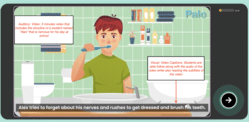
|
| Visual – watching or seeing | More Videos: In general, Palo has done very well on the visual sense being incorporated into every slide of the lesson plan. One possible recommendation would be to include more videos to have a wide range of visuals used throughout the lesson plan | 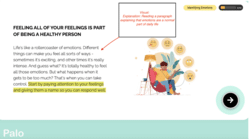
|
| Kinesthetic – body movement or physical activity | Additional Exercises: While Palo is an online learning resource, if applicable, adding exercises that use body movement can add to the SEL experience. For example, a role-playing exercise where students are assigned a role in a scene between fictional characters to act out healthy expressions of their emotions. Creating activities that are provided outside of the online platform can allow students to create deeper connection with the material. | |
| Tactile – learning through the sense of touch ** Since Palo is taught primarily online, tactile is defined here as using the keyboard to interact with the lesson on screen | Interactive Experience: Even though there are sections of the lesson that include the use of the tactile sense, including more activities where students have to interact with the material would be beneficial to activate the student’s tactile sense. | 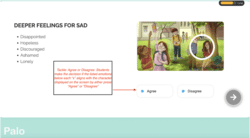
|
Evaluation: the use of BOBBI in Palo
The table below delineates the application of the BOBBI framework’s teaching strategies within the “Identifying Emotions” lesson from Palo’s SEL program. Each strategy from the BOBBI framework is evaluated against the elements presented in each slide of the lesson. The inclusion of a BOBBI element in a slide is marked if the slide content aligns with the defined categories of the BOBBI framework, aimed at supporting students with ADHD.
| Element to consider | Recommendation | Example on Palo |
| Give Transition Warnings | Additional Transition Warnings: This slide is a prime example of what transition warning should be given to students before participating in any activities. Adding more slides to the lesson plan can help create a buffer between switching between two different concepts without explaining the purpose of each activity. Transition warnings allow students to fully understand what is asked of them in the following task and what the purpose of the task is. | 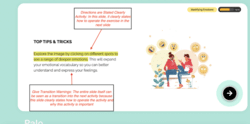
|
| Breaking Down Directions Into Chunks | Palo has done a great job of keeping directions into small digestible chunks of information for students to understand. | 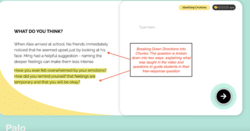
|
| Brain Breaks | Include Brain Breaks: One of the most essential elements to support children with ADHD is the incorporation of brain breaks. Brain breaks allow students to let themselves rest before re-focusing on the activities. It can be hard for students with ADHD to shift focus from one activity to another. Brain breaks will help students to self-orientate themselves back onto the tasks at hand and ultimately aid them to gain a deeper understanding of the SEL material. | |
| Frequent Feedback + Positive Reinforcement | 1. Feedback: While there are a few examples of positive reinforcement, there is little to no feedback given to students. Giving feedback to students about why the answer they chose was either correct or incorrect can help to understand where they may have gone wrong and aid them in healthy redirection toward the correct answer. 2. Positive Reinforcement: Additional positive reinforcement can aid students in staying motivated in learning the material as they want to continue to answer the questions correctly. Positive reinforcement will solidify to students that the actions and effort they are putting into the SEL program will give them a positive learning experience. | 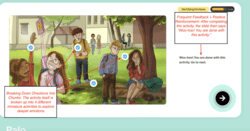
|
| Directions are Stated Clearly | More direction: Throughout the lesson, many activities are administered for students to interact with the SEL material. However, there is usually little direction about what is expected of the students in the activity. This slide is a prime example of the formatting every activity should have in order for students to understand exactly what the expectations are for every activity. | 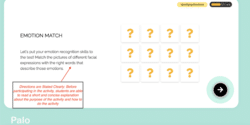
|
Breaking Down Palo: The Importance of Investigating Inclusivity Through Templates
Advancing toward greater inclusivity in Palo’s lesson plans signifies a crucial stride towards fostering a conducive learning environment, especially for neurodivergent students. While the recommendations outlined in this paper may appear subtle, they hold substantial potential to transform the educational experience for neurodivergent learners. Embracing these inclusive practices enhances the accessibility and overall quality of Palo’s online resources, catering to a broader spectrum of learners. The initiatives go beyond aiding neurodivergent students, offering a supportive learning milieu that augments the educational journey for all students. The evaluative framework proposed herein serves as a structured pathway, shedding light on essential characteristics to consider while assessing the inclusivity of online resources, aiming for continuous improvement.
The recommendations, including the integration of the BOBBI framework for ADHD and enhanced auditory support for dyslexic students, present cogent steps toward a more inclusive learning ecosystem. For instance, the absence of transition warnings in the lesson plan highlighted an improvement area, with the proposition to embed simple transition warnings across slides. Similarly, introducing an auditory aid feature emerges as a creative solution to bolster support for dyslexic students, thereby enhancing their engagement and comprehension. As Palo heeds these insights and recommendations, the horizon for creating a more inclusive, supportive, and effective SEL program broadens, underscoring the attainability of better inclusivity and the monumental positive outcomes that await neurodivergent students, thereby elevating the educational landscape.
Limitations:
This research presents certain limitations that warrant attention. First, the analysis is based on a single lesson plan from Palo’s repertoire of 96 lesson plans, which might not provide a comprehensive view of Palo’s inclusivity across its entire program. A more robust evaluation would necessitate a thorough examination of multiple lesson plans employing consistent evaluative standards.
Second, the variety of tools and strategies available for supporting neurodivergent students underscores the unique needs each student may have. The integrations aimed at addressing dyslexia and ADHD are commendable but might not cater to all students with these conditions. Lastly, the effectiveness of Palo could significantly hinge on the adaptive strategies employed by teachers to personalize the learning experience, compensating for any inherent lack of support within Palo.
Author’s Thoughts:
The challenges neurodivergent students face can be amplified in the absence of adequate support from school administrations. Issues can span a lack of resources, unavailability of personalized recommendations, or peer acceptance. A significant concern is the predicament of undiagnosed students; as cited by the Learning Disabilities Association of America, about 60% of adults with literacy challenges have undiagnosed learning disabilities. Early interventions and provision of necessary accommodations can substantially bolster the academic trajectory of these students.
The objective for educators is to create a classroom environment that resonates with the needs of all students. However, the diverse and individualized accommodations each student requires makes this a complex endeavor. This necessitates a reflective approach by educators to identify and implement necessary improvements within the classroom setting. While it may seem ambitious to meet every student’s needs, striving toward creating a more inclusive environment is an attainable goal. Thoughtful considerations regarding the provision of additional support and accommodations can markedly enhance the educational experience of students, forging a pathway for them to realize their full potential.
Reference
7 reasons why students need technology in the classroom. Explorance. (2023, May 23). https://explorance.com/blog/7-reasons-students-need-technology-classroom/#:~:text=Access%20to%20information%20and%20resources,be%20available%20in%20traditional%20textbooks
Accommodation Central. (n.d.). Chunking. http://acentral.education/accommodations/chunking#:~:text=Chunking%20long%20assignments%20and%20projects,%2C%20organization%2C%20and%20time%20management
Dwyer , P. (2023, March 13). Building neurodiversity-inclusive postsecondary campuses … https://www.liebertpub.com/doi/10.1089/aut.2021.0042
Goodall, E., Brownlow, C., Fein, E. C., & Candeloro, S. (2022, July 22). Creating inclusive classrooms for highly dysregulated students: What can we learn from existing literature?. MDPI. https://www.mdpi.com/2227-7102/12/8/504
Gretchen Vierstra, M. (2023, June 15). ADHD teaching strategies. Understood. https://www.understood.org/en/articles/adhd-teaching-strategies
Heraty, Calum & Mac an Bhaird, Ciarán & Mulligan, Peter & O’Malley, James & O’Neill, Rachel. (2021). A trial of resources to support students with Dyslexia. MSOR Connections. 19. 13-21. 10.21100/msor.v19i1.1136.
Luke. (2023, July 11). Neurodiversity and online barriers: News. https://reciteme.com/us/news/neurodiversity-and-online-barriers/
Multisensory learning and teaching for dyslexic students. Dyslexia Reading Well. (n.d.). https://www.dyslexia-reading-well.com/multisensory-learning.html#:~:text=Multisensory%20learning%20provides%20more%20ways,involves%20memorizing%20sequences%20or%20steps
Multisensory learning for dyslexia. Prayatna. (2023, September 13). https://prayatna.co.in/multisensory-learning-for-dyslexia/
Nicolson, Roderick & Fawcett, Angela. (2008). Dyslexia, Learning, and the Brain. 10.7551/mitpress/9780262140997.001.0001.
Orpi, D. (2022, September 9). What is multisensory learning & how to implement multisensory teaching. Thrive Literacy Corner. https://thriveedservices.com/what-is-multisensory-learning-and-how-to-implement-multisensory-teaching/Singh, M. (2022, July 16). Severity levels of dyslexia. Number Dyslexia. https://numberdyslexia.com/severity-levels-of-dyslexia/#:~:text=Three%20Levels%20of%20Dyslexia&text=Therefore%2C%20it%20is%20required%20to,mild%2C%20moderate%20and%20severe%20dyslexia


